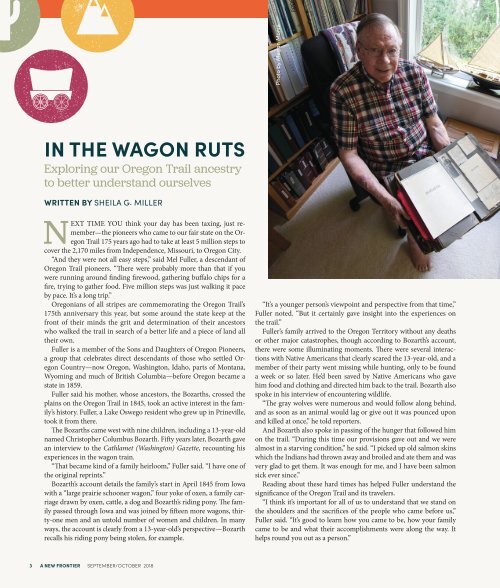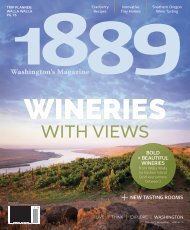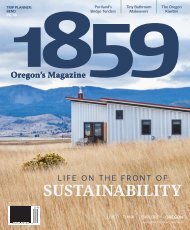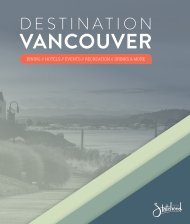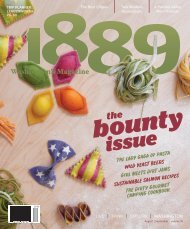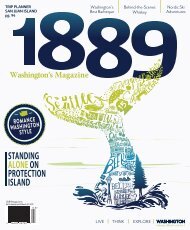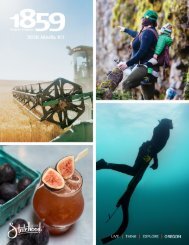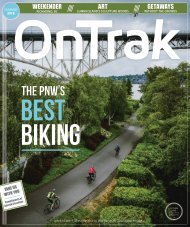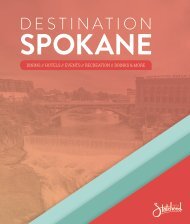Travel Oregon Special Insert Sept | Oct 2018
You also want an ePaper? Increase the reach of your titles
YUMPU automatically turns print PDFs into web optimized ePapers that Google loves.
Photo by Megan Morse<br />
IN THE WAGON RUTS<br />
Exploring our <strong>Oregon</strong> Trail ancestry<br />
to better understand ourselves<br />
WRITTEN BY SHEILA G. MILLER<br />
NEXT TIME YOU think your day has been taxing, just remember—the<br />
pioneers who came to our fair state on the <strong>Oregon</strong><br />
Trail 175 years ago had to take at least 5 million steps to<br />
cover the 2,170 miles from Independence, Missouri, to <strong>Oregon</strong> City.<br />
“And they were not all easy steps,” said Mel Fuller, a descendant of<br />
<strong>Oregon</strong> Trail pioneers. “There were probably more than that if you<br />
were running around finding firewood, gathering buffalo chips for a<br />
fire, trying to gather food. Five million steps was just walking it pace<br />
by pace. It’s a long trip.”<br />
<strong>Oregon</strong>ians of all stripes are commemorating the <strong>Oregon</strong> Trail’s<br />
175th anniversary this year, but some around the state keep at the<br />
front of their minds the grit and determination of their ancestors<br />
who walked the trail in search of a better life and a piece of land all<br />
their own.<br />
Fuller is a member of the Sons and Daughters of <strong>Oregon</strong> Pioneers,<br />
a group that celebrates direct descendants of those who settled <strong>Oregon</strong><br />
Country—now <strong>Oregon</strong>, Washington, Idaho, parts of Montana,<br />
Wyoming and much of British Columbia—before <strong>Oregon</strong> became a<br />
state in 1859.<br />
Fuller said his mother, whose ancestors, the Bozarths, crossed the<br />
plains on the <strong>Oregon</strong> Trail in 1845, took an active interest in the family’s<br />
history. Fuller, a Lake Oswego resident who grew up in Prineville,<br />
took it from there.<br />
The Bozarths came west with nine children, including a 13-year-old<br />
named Christopher Columbus Bozarth. Fifty years later, Bozarth gave<br />
an interview to the Cathlamet (Washington) Gazette, recounting his<br />
experiences in the wagon train.<br />
“That became kind of a family heirloom,” Fuller said. “I have one of<br />
the original reprints.”<br />
Bozarth’s account details the family’s start in April 1845 from Iowa<br />
with a “large prairie schooner wagon,” four yoke of oxen, a family carriage<br />
drawn by oxen, cattle, a dog and Bozarth’s riding pony. The family<br />
passed through Iowa and was joined by fifteen more wagons, thirty-one<br />
men and an untold number of women and children. In many<br />
ways, the account is clearly from a 13-year-old’s perspective—Bozarth<br />
recalls his riding pony being stolen, for example.<br />
“It’s a younger person’s viewpoint and perspective from that time,”<br />
Fuller noted. “But it certainly gave insight into the experiences on<br />
the trail.”<br />
Fuller’s family arrived to the <strong>Oregon</strong> Territory without any deaths<br />
or other major catastrophes, though according to Bozarth’s account,<br />
there were some illuminating moments. There were several interactions<br />
with Native Americans that clearly scared the 13-year-old, and a<br />
member of their party went missing while hunting, only to be found<br />
a week or so later. He’d been saved by Native Americans who gave<br />
him food and clothing and directed him back to the trail. Bozarth also<br />
spoke in his interview of encountering wildlife.<br />
“The gray wolves were numerous and would follow along behind,<br />
and as soon as an animal would lag or give out it was pounced upon<br />
and killed at once,” he told reporters.<br />
And Bozarth also spoke in passing of the hunger that followed him<br />
on the trail. “During this time our provisions gave out and we were<br />
almost in a starving condition,” he said. “I picked up old salmon skins<br />
which the Indians had thrown away and broiled and ate them and was<br />
very glad to get them. It was enough for me, and I have been salmon<br />
sick ever since.”<br />
Reading about these hard times has helped Fuller understand the<br />
significance of the <strong>Oregon</strong> Trail and its travelers.<br />
“I think it’s important for all of us to understand that we stand on<br />
the shoulders and the sacrifices of the people who came before us,”<br />
Fuller said. “It’s good to learn how you came to be, how your family<br />
came to be and what their accomplishments were along the way. It<br />
helps round you out as a person.”<br />
3 A NEW FRONTIER SEPTEMBER/OCTOBER <strong>2018</strong>


